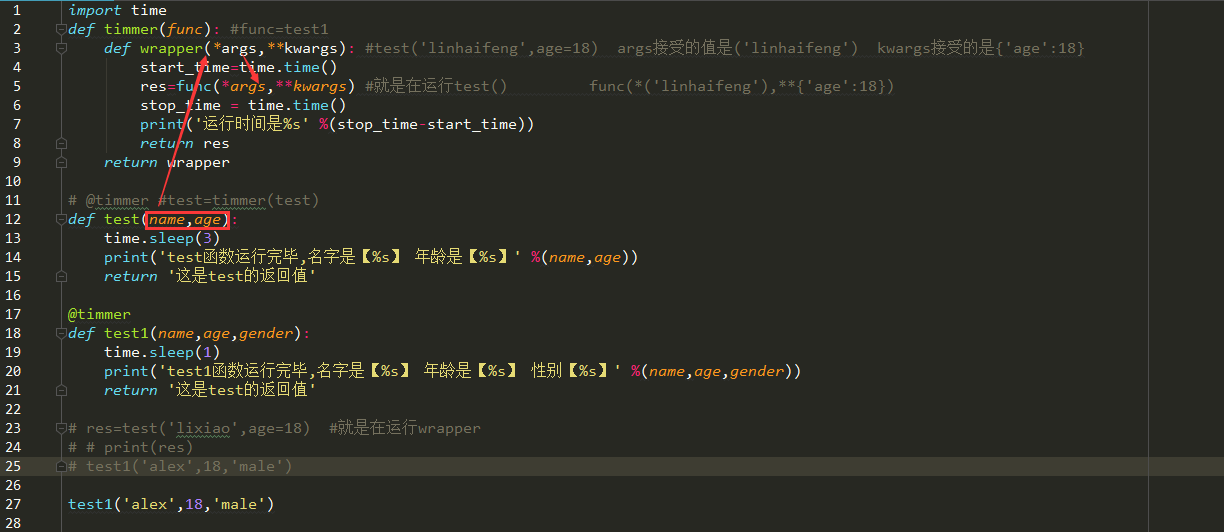一. 装饰器
装饰器:可以拆解来看,器本质就是函数,装饰就是修饰的意思,所以装饰器的功能就是为其他函数添加附加功能。
装饰器的两个原则:
1. 不修改被修饰函数的源代码
2. 不修改被修饰函数的调用方式
实现装饰器的知识储备: 装饰器 = 高阶函数 + 函数嵌套 + 闭包
高阶函数
高阶函数的定义:
1. 函数接收的参数是一个函数名
2. 函数的返回值是一个函数名
3.满足上述条件任意一个,都可以称之为高阶函数
import time # 示例1: 函数接收的参数是一个函数名 # def foo(): # print("Hello") # # def test(func): # print(func) # func() # # test(foo) # 示例2:函数test接收的参数是一个函数名foo,可以直接为foo函数增加一个功能 # 需求:想统计foo运行的时间,结果这个高阶函数修改了函数的源代码 # def foo(): # time.sleep(2) # print("Hello") # # def test(func): # print(func) # start_time = time.time() # func() # stop_time = time.time() # print('函数的运行时间是:%s '%(stop_time-start_time)) # 统计的是func()的运行时间,即foo的运行时间 # # test(foo) # 示例3:函数的返回值是一个函数名 def foo(): print("from the foo") def test(func): return func # 实现了装饰器的不改变函数的调用方式这个功能 foo = test(foo) foo() # 示例4: 示例2+示例3就能实现一个半完整的装饰器 def foo(): time.sleep(3) print('来自foo') # 不修改foo源代码 # 不修改foo调用方式
# 没有修改被修饰函数的源代码,也没有修改被修饰函数的调用方式,但是也没有为被修饰函数添加新功能
def timer(func): start_time = time.time() func() stop_time = time.time() print('函数的运行时间是:%s '%(stop_time-start_time)) # 统计的是func()的运行时间,即foo的运行时间 return func foo = timer(foo) # timer函数的返回值是foo,在把返回值又赋值给了foo,得到一个内存地址 foo() # 有了内存地址,直接加个()就可以运行。 # 结果 # 来自foo # 函数的运行时间是:3.001082420349121 # 来自foo # 上面说的是半完整的装饰器,是因为这里多运行了一次foo,肯定不行那,这就导致这个装饰器就不合格了
函数嵌套
# 函数嵌套及作用域
# father()函数里嵌套了一层son()函数,son()函数里又嵌套了一层grandson()函数 def father(name): print('from father %s' %name) # name变量的作用域,是传进来的DDD def son(): # 函数也是变量 name='abc' print('我的爸爸是%s' %name) # 作用域是son函数自己定义的name变量 def grandson(): print('我的爷爷是%s' % name) # grandson函数没有自己的name变量,需要往上一级一级找,找到了son函数,就是abc # 同调用son的道理一样,需要通过father调用son,通过son函数再调用grandson函数 grandson() # 如果要调用son函数,不能跑到father的外面去调用,会报错;只能通过调用father来调用son函数 # 此处是调用son函数 son() father('DDD')
son('abcx') # 报错 # son函数定义在father里,所以只能通过father调用son函数
闭包
上面理解了函数的层级嵌套,就很好理解闭包的概念。嵌套的函数换个名称叫闭包
包:就像一个盒子套着一个盒子,一层层往外套,每一次都是一个包
闭:就是封装,封装变量。每个包都有被封装的变量。
下面画图解释

闭包如何找变量?
还是先从自己的闭包里开始找变量,自己没有在往上一层包里找变量,如果还没有,可以一直往外找,可以一直找到最外层
装饰器基本实现
首先, # 搭个装饰器的架子,满足高阶函数,满足函数嵌套 import time def timer(func): def wrapper(): # print(func) # 嵌套函数也可以获取传入的参数,传入的参数也是个函数,作用域在起作用 这是个内存地址 func() # 有了内存地址,加()就可以执行func函数 return wrapper def test(): time.sleep(2) print("test函数运行完毕") 其次, 有个需求:不修改test函数的原代码,也不修改test函数的调用方式,而且为test函数增加一个统计运行时间的功能 实现该需求的流程分析及代码运行过程: # 流程分析: # 1. 把test函数传给timer,直接返回的是wrapper的地址,而没有运行wrapper函数 res = timer(test) # 2. 上面返回的是wrapper函数的内存地址,所以就可以直接加()执行wrapper函数 res() # 执行的是wrapper函数 # 3. 再看wrapper函数做了什么? # wrapper 函数运行的是func函数,而func函数就是传入的test()函数,所以执行wrapper就可以执行test()函数 # 所以,这个时候就可以添加代码来统计test函数的运行时间了。 至此, # 上面的代码就演化成为: def timer(func): def wrapper(): start_time = time.time() func() stop_time = time.time() print("test函数的运行时长是: %s" % (stop_time - start_time)) return wrapper def test(): time.sleep(2) print("test函数运行完毕") res = timer(test) res() # 运行结果 test函数运行完毕 test函数的运行时长是: 2.000473976135254 但是,这里有 个问题,需求是不修改test函数的调研方式,test函数的调用方式应该是test(),而这里的调用方式是res() 所以,解决修改了test函数调用方式这个问题的方法: # 将timer(test)的值赋给变量test test = timer(test) # 然后再test()调用,这样就达到了没有修改test函数调用方式的目的 test() #到这里,一个装饰器的架子和调用模型就初步成型了,但是还需要赋值给test变量这一步操作 # 所以,最后, python为了实现这个不修改test函数调用方式,也省略赋值这行代码,而产生了一个装饰器的概念 # 上面的代码就进化为: # 装饰器 def timer(func): def wrapper(): start_time = time.time() func() stop_time = time.time() print("test函数的运行时长是: %s" % (stop_time - start_time)) return wrapper @timer #在test函数的顶头加上 @timmer来修饰test函数, 就相当于 test=timmer(test) 这个赋值动作 def test(): time.sleep(2) print("test函数运行完毕") # 有了装饰器,就可以直接调用test函数 test() # 终于啊,老天爷啊,历经千辛万苦,终于完美的满足了最开始的需求
为闭包加上返回值
还是接上面的基本装饰器来说
def timer(func): def wrapper(): start_time = time.time() func() stop_time = time.time() print("test函数的运行时长是: %s" % (stop_time - start_time)) return wrapper # 需求:给test函数加一个返回值: “test函数返回好消息了” @timer def test(): time.sleep(2) print("test函数运行完毕") return "test函数返回好消息了" res=test() print(res) #结果 test函数运行完毕 test函数的运行时长是: 2.000929117202759 None 返回None了 # 为什么会这样呢?分析如下: # 1. 运行test函数,因为有装饰器,实际上运行的是wrapper这个闭包,而wrapper函数却没有返回值,所以返回的是None,那么给wrapper函数加个返回值呢? 代码如下: def timer(func): def wrapper(): start_time = time.time() func() stop_time = time.time() print("test函数的运行时长是: %s" % (stop_time - start_time)) return 123 # 给wrapper函数加的返回值 return wrapper @timer def test(): time.sleep(2) print("test函数运行完毕") return "test函数返回好消息了" res = test() print(res) # 结果 test函数运行完毕 test函数的运行时长是: 2.0010011196136475 123 # 返回的是123, # 上面运行返回的是123,而我们的需求是要返回“test函数返回好消息了” # 接着开,wrapper函数运行的是func函数,而func函数就是传入的test函数,所以把 func()赋值给变量 res呢? # 代码如下: def timer(func): def wrapper(): start_time = time.time() res = func() # 赋值给res stop_time = time.time() print("test函数的运行时长是: %s" % (stop_time - start_time)) return res # 返回res return wrapper @timer def test(): time.sleep(2) print("test函数运行完毕") return "test函数返回好消息了" res = test() print(res) # 结果 test函数运行完毕 test函数的运行时长是: 2.0009818077087402 test函数返回好消息了 # 至此,给装饰器加上返回值就实现了。 # 但是还有个问题,如果直接调用test呢? test() # 结果如下,为什么?暂时还不明白 test函数运行完毕 test函数的运行时长是: 2.0001914501190186
为闭包加上参数

# 需求:给test传入参数 import time def timmer(func): #func=test1 def wrapper(): start_time=time.time() res=func() stop_time = time.time() print('运行时间是%s' %(stop_time-start_time)) return res return wrapper @timmer #test=timmer(test) def test(name,age): time.sleep(3) print('test函数运行完毕,名字是【%s】 年龄是【%s】' %(name,age)) return '这是test的返回值' res=test('lixiao',age=18) #就是在运行wrapper print(res) #结果: 报错 为什么呢? 因为运行test就是在运行wrapper,而test传入了参数,wrapper里却没有接受参数,所以就报错了。那怎么改呢? 1. 礼尚往来,你给我得接着呀,所有wrapper需要有参数接受test传来的值。 2. wrapper 接受到了传来的值,wrapper函数体内,运行的res=func()实际上就是test(),所以,wrapper接受的参数也要传给func()才行。 import time def timmer(func): #func=test1 def wrapper(*args,**kwargs): start_time=time.time() res=func(*args,**kwargs) stop_time = time.time() print('运行时间是%s' %(stop_time-start_time)) return res return wrapper @timmer #test=timmer(test) def test(name,age): time.sleep(3) print('test函数运行完毕,名字是【%s】 年龄是【%s】' %(name,age)) return '这是test的返回值' #备注: wrapper(*args,**kwargs):表示的是可变长参数 # *args: 代表把所有的位置参数接成列表 # **kwargs: 代表可能用户传值的时候通过关键字传值,比如用户传的值是age =18, 或者{"age": 18}形式的, 就用**kwargs来接 # 所以,*args,**kwargs :代表可变长参数,传多少参数,任意形式的都可以接受了 @timmer def test1(name,age,gender): time.sleep(1) print('test1函数运行完毕,名字是【%s】 年龄是【%s】 性别【%s】' %(name,age,gender)) return '这是test的返回值' test1('alex', 18, gender='male')
闭包:补充解压序列 (很有用)
# 需求:有个很长的列表,拿出第一个和最后一个值 l = [1,2,4,5,6,123,34,1,6] 方式1:索引的方式 print(l[0]) print(l[-1]) 方式2:解压序列方式 l = [1,2,4,5,6,123,34,1,6] a, *_, c = l print(a) # 1 print(*_) # 2 4 5 6 123 34 1 print(c) # 6 # a 代表取第一个值 # * 代表所有的值,下划线_表示不要了,当然下划线可以有任意字符替换, 如 *b, *d都可以 # c 代表最后一个值了 # 需求:a =1, b=2, 交换a,b的值 a = 1 b = 2 a,b = b,a print(a) # 2 print(b) # 1
函数闭包为函数加上认证功能
def auth_func(func): def wrapper(*args, **kwargs): username = input('用户名: ').strip() password = input("密码: ").strip() if username =="sb" and password == "123321": # 用户是写死了 res = func(*args, **kwargs) return res # 切记要有返回值那 else: print("用户名或密码错误") return wrapper @auth_func def index(): print("欢迎来到京东") @auth_func def home(): print("欢迎回家") @auth_func def shopping_box(name): print("%s的购物车里有%s,%s,%s" % (name, '娃娃', '电脑','手机')) index() home() shopping_box('韩梅梅')
函数闭包模拟session
上面为每个功能都加了验证功能,但是每次运行其他功能都需要重新登陆,这显然是不合理的,可以用session和cookie来解决,那怎么模拟解决这个问题呢?
还有一个问题,就是用户是写死的,而实战中,我们的用户不可能只有一个,而且写死,所以这里也是需要改造的。
# 用户一般都是存在数据库里,这里为了方便模拟,就把用户存储在一个列表里 user_list = [ {'name': 'sb', 'passwd': '123'}, {'name': 'lhf', 'passwd': '123'}, {'name': 'wpq', 'passwd': '123'}, {'name': 'yh', 'passwd': '123'}, ] current_dic = {'username':None, 'login':False} # 模式当前登录状态是FALSE,未登录 def auth_func(func): def wrapper(*args, **kwargs): # 在运行wrapper之前, 先判断是否有用户登录 if current_dic['username'] and current_dic['login']: # 这个代表的是由用户登录且是true,然后直接运行func() res= func(*args, **kwargs) return res # 如果上面的判断不为True,则输入用户名和密码 username = input("用户名:") password = input("密 码:") # 输完后应该从user_list里提取信息 for user in user_list: # 然后判断输入的用户名和密码与user_list里的是否一致 if username == user['name'] and password == user['passwd']: # 如果有一致的, 要把当前状态改一下 current_dic['username'] = username # 记录状态的字典里用户名 = 用户输入的用户名 current_dic['login'] = True # 登陆状态改为true res = func(*args, **kwargs) return res # 切记要有返回值那 # 如果遍历了一遍,都没有匹配的 else: print("用户名或密码错误") return wrapper @auth_func def index(): print("欢迎来到京东") @auth_func def home(): print("欢迎回家") @auth_func def shopping_box(name): print("%s的购物车里有%s,%s,%s" % (name, '娃娃', '电脑','手机')) index() home() shopping_box('韩梅梅')
函数闭包带参数装饰器-----带参数的装饰器
user_list=[ {'name':'alex','passwd':'123'}, {'name':'linhaifeng','passwd':'123'}, {'name':'wupeiqi','passwd':'123'}, {'name':'yuanhao','passwd':'123'}, ] current_dic={'username':None,'login':False} def auth(auth_type='filedb'): def auth_func(func): def wrapper(*args,**kwargs): print('认证类型是',auth_type) if auth_type == 'filedb': if current_dic['username'] and current_dic['login']: res = func(*args, **kwargs) return res username=input('用户名:').strip() passwd=input('密码:').strip() for user_dic in user_list: if username == user_dic['name'] and passwd == user_dic['passwd']: current_dic['username']=username current_dic['login']=True res = func(*args, **kwargs) return res else: print('用户名或者密码错误') elif auth_type == 'ldap': print('鬼才特么会玩') res = func(*args, **kwargs) return res else: print('鬼才知道你用的什么认证方式') res = func(*args, **kwargs) return res return wrapper return auth_func @auth(auth_type='filedb') #auth_func=auth(auth_type='filedb')-->@auth_func 附加了一个auth_type --->index=auth_func(index) def index(): print('欢迎来到京东主页') @auth(auth_type='ldap') def home(name): print('欢迎回家%s' %name) # @auth(auth_type='sssssss') def shopping_car(name): print('%s的购物车里有[%s,%s,%s]' %(name,'奶茶','妹妹','娃娃')) # print('before-->',current_dic) index() # print('after--->',current_dic) home('产品经理') shopping_car('产品经理')